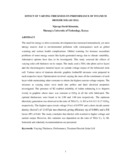Effect of Varying Thickness on Performance of Titanium Dioxide Solar Cell
Abstract
The need for energy to drive economic development has increased tremendously yet most energy sources lead to environmental pollution with consequences such as global warming and serious health complications. Global warming for instance exacerbate problems of some energy source like hydro-generated energy due to climate variability. Alternative options have thus to be investigated. This study assessed the effects of varying solar cell thickness on its output. The study used a TiO2 (the photo active layer) and the electronegative material layers on current-voltage output of the fabricated solar cell. Various ratios of titanium dioxide: graphite /iodine/KI mixtures were prepared in each respective layer. Optimization involved varying the mass of the constituents of each layer while maintaining other constants to obtain the highest current-voltage outputs. The mixtures at varying ratios were made into pellets and their electrical properties investigated. The presence of KI enabled solubility of iodine enhancing it to disperse evenly in graphite whose mass was constant at 0.01g in all the cells fabricated. The optimal thicknesses were found to be 2.00 and 1.00 mm respectively. The optimum electricity generation was observed at the ratio of TiO2/ Cx: I2: KI as 0.4: 0.3: 0.17: 0.01g, respectively. The highest open circuit voltage (Voc) of 0.979V and a short circuit current density (Jsc/cm2) of 12.037μA was observed, giving efficiency (η) of 0.006% and a Fill factor (FF) of 0.64. The study concludes that thicker cells resulted to higher voltage and current output. However, this variation was dependent on the ratio of TiO2/ Cx: I2: KI. Industrial and scholarly recommendations are presented.

